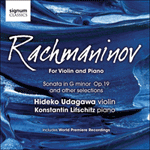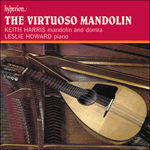
Welcome to Hyperion Records, an independent British classical label devoted to presenting high-quality recordings of music of all styles and from all periods from the twelfth century to the twenty-first.
Hyperion offers both CDs, and downloads in a number of formats. The site is also available in several languages.
Please use the dropdown buttons to set your preferred options, or use the checkbox to accept the defaults.

The Op 6 pieces share the same key, D minor, and the relatively extended Romance opens at once with the main theme on the violin, heard against a flowing accompaniment. A developmental counter-statement of this theme has the violin mostly in octaves, while the piano writing is also fuller and more dramatic. This leads to a relatively straightforward recapitulation before a brief but effective cadenza for the violin heralds the concluding four bars, rooted to D minor. The Danse hongroise, marked ‘Vivace’, is a brilliant piece, very typical of Rachmaninov (especially in the accompanimental keyboard figure), which at one point seems to echo an idea from the main theme of the Romance. Such is the composer’s mastery of violin writing (though he may well have enlisted Conus’s assistance in this regard) that one regrets that he did not leave a more extended work for the instrument.
from notes by Robert Matthew-Walker © 2000
Les pièces de l’op.6 partagent une même tonalité (ré mineur), et la Romance, relativement étendue, s’ouvre d’emblée sur le thème principal au violon, entendu contre un accompagnement fluide. Une contre-exposition de développement de ce thème voit le violon essentiellement en octaves, cependant que l’écriture pianistique est plus entière et davantage dramatique. Ce qui aboutit à une reprise assez simple; puis une brève, mais efficace, cadenza dévolue au violon annonce les quatre mesures conclusives, enracinées dans ré mineur. Marquée «Vivace», la Danse hongroise est une pièce brillante, toute rachmaninovienne (surtout dans la figure accompagnante, au clavier), qui, à un moment, semble renvoyer une idée du thème principal de la Romance. La maîtrise de l’écriture violonistique de Rachmaninov est telle (même s’il a pu recourir à l’aide de Conus) que l’on regrette qu’il n’ait pas laissé d’œuvre pour violon plus imposante.
extrait des notes rédigées par Robert Matthew-Walker © 2000
Français: Hypérion
Die Stücke op. 6 stehen beide in der gleichen Tonart (d-Moll), und die relativ umfangreiche Romance beginnt mit dem Hauptthema auf der Geige vor fließender Begleitung. In der durchführenden Entgegnung des Themas hat die Geige vorwiegend Oktaven zu spielen, und auch die Klavierführung ist ausgefüllter und dramatischer. Es folgt eine relativ geradlinige Reprise, ehe eine kurze, aber effektvolle Kadenz der Geige zu den in d-Moll verwurzelten letzten vier Takten überleitet. Der „Vivace“ überschriebene Danse hongroise ist ein brillantes Stück, ausgesprochen typisch für Rachmaninow (insbesondere in der begleitenden Klavierfigur), in dem an einer Stelle eine Idee aus dem Hauptthema der Romance widerzuhallen scheint. Der Komponist beherrscht die Violinführung so meisterhaft (auch wenn er in dieser Hinsicht Conus’ Hilfe in Anspruch genommen haben könnte), daß es bedauerlich ist, daß er kein ausführlicheres Werk für das Instrument hinterlassen hat.
aus dem Begleittext von Robert Matthew-Walker © 2000
Deutsch: Anne Steeb/Bernd Müller
 Rachmaninov: Violin Sonata & other works Rachmaninov: Violin Sonata & other worksHideko Udagawa has performed extensively throughout the world and has captivated international audiences with her artistry and enthusiasm. On this album she is expertly accompanied by Konstantin Lifschitz.» More |
 The Virtuoso Mandolin The Virtuoso Mandolin |

